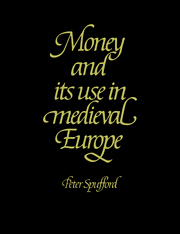Book contents
- Frontmatter
- Contents
- List of maps
- List of tables
- List of graphs
- Acknowledgements
- Introduction
- Part I Before the Commercial Revolution
- Part II The Commercial Revolution of the Thirteenth Century
- Part III The Late Middle Ages
- Conclusion
- Appendix I The Coins Most Commonly in Use in the Middle Ages
- Appendix II Money of Account
- Appendix III Production at Some Later Medieval Mints
- Bibliography
- Coin Index
- General Index
Appendix II - Money of Account
Published online by Cambridge University Press: 23 November 2009
- Frontmatter
- Contents
- List of maps
- List of tables
- List of graphs
- Acknowledgements
- Introduction
- Part I Before the Commercial Revolution
- Part II The Commercial Revolution of the Thirteenth Century
- Part III The Late Middle Ages
- Conclusion
- Appendix I The Coins Most Commonly in Use in the Middle Ages
- Appendix II Money of Account
- Appendix III Production at Some Later Medieval Mints
- Bibliography
- Coin Index
- General Index
Summary
In most parts of late medieval Europe, and in many places up to the eighteenth or even the nineteenth century, a dichotomy existed in the functions of money. On the one hand money of account was the measure of value, whilst on the other, the actual coin was the medium of exchange, and the store of wealth.
Money of account derived its name from its function. As a measure of value it was used almost exclusively for accounting purposes. Most financial transactions were first determined and expressed in money of account, although payments were naturally made subsequently in coin, or surprisingly often in other goods. Coin itself was valued as a commodity in terms of money of account, and, as with any other commodity, its value frequently varied. This variation of the value of coin in terms of money of account has been the cause of much confusion of thought about the nature of money of account. This confusion of thought has resulted in the expression of a differing concept of money of account by practically every writer on medieval money.
With the decline of the denier at different rates in different places in the eleventh and twelfth centuries, a standard of reference was needed for the wide variety of deniers that might be circulating in any region in addition to the indigenous coinage. Such a need was particularly felt in such regions as Champagne because of the fairs.
- Type
- Chapter
- Information
- Money and its Use in Medieval Europe , pp. 411 - 414Publisher: Cambridge University PressPrint publication year: 1988



